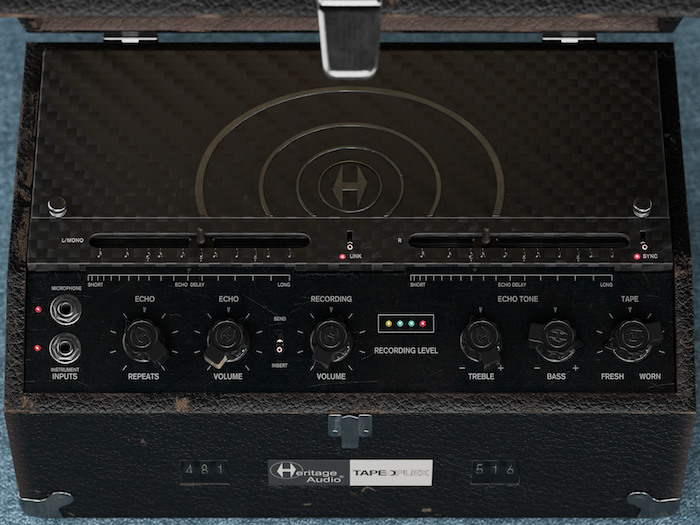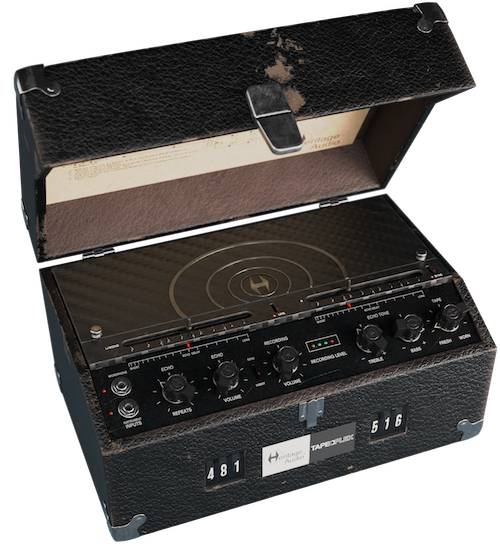
| Back To The Directory |
Heritage Audio TAPEoPLEX
By Barry Rudolph
Heritage Audio is at it again. They have found another old vintage unit, working or not, and discovered its magic and created an unique plug-in emulation. This time it is the classic Maestro Echoplex EP-4. In a respectful way, they have improved, refined and modernized it for all DAW users.
 |
| Heritage Audio TAPEoPLEX GUI |
The TAPEoPlex plug-in replicates the Maestro Echoplex EP-4. An analog delay that used a ¼-inch tape loop with a movable playback head to set delay times. The Heritage Audio TAPEoPlex adds features I always wanted back in the day. The biggest modernization is stereo operation with two separate tape delay outputs and sliders that either work separately or linked together. The other modern feature is the addition of tempo sync for locking delay times to your DAW's tempo. This was unheard of back in the day.
Updated Controls
TAPEoPlex's front panel has the same horizontal sliders for setting the delay times like the original Echoplex. But now there are two sliders (instead of one) for setting delay times for the left and right outputs separately. Once linked together, they change together. If they are synchronized to the session tempo, you can set whatever musical note or delay time for either delay by clicking on its slider and moving it to the left for shorter delay time or right for longer times. The first trick I tried was moving these sliders while audio was looping. Cool effect: move the delay time to shorter time to the right and the pitch of repeats goes up in pitch. Conversely, when you move it to the right for a slower delay time and the pitch goes down..
 |
| Heritage Audio TAPEoPLEX Unit |
If you set the delay times in musical notes and change them to un-synced, delay times are shown in milliseconds. If the delays are not tempo sync'd, when you click to tempo sync them, the two delays automatically change to the nearest subdivision. I liked this feature a lot! However, you cannot separately un-sync one delay from the other. No big deal since you can use a second instance of TAPEoPlex for that..
Link works like grouping two track faders in your DAW. Clicking on Link causes the Right Output to copy the Left Output's delay time. Once that happens, you can unlink and change the L/R delays to different times. .
Colorful Sounds.
TAPEoPLEX has different ways to induce analog color. Besides the regular Line Input there is a Mic Input. The mic input has much more gain and this extra level is easily added to an already running loop. Using the Mic input distorts in a warm way and is the start of some interest sound design sounds. Since all controls can be automated, I could automate Repeats or Feedback, Echo Volume and Recording Level and more.
The Repeats control is feedback and sets how many slap-back echoes occur. The Volume knob controls the level of the echoes as there is not Wet/Dry control. TAPEoPLEX is a Send/Return effect but there is a button to use it as an Insert. I preferred inserting it as Mono/Stereo plug-in for a very spacious, stereo effect. I would adjust the number of repeats, and then using the Echo Volume control to get a mix level of the effect. If you adjust both outputs to the same time, you'll get a wide stereo delay because of the slight time difference between the two outputs that doesn't seem to cancel out when summed to mono. .
By running a hot level set on the Recording control is like overloading an analog tape machine. The sound of the repeats gets dirtier and dirtier with every repeat. A caveat with the original machines was that they require changing the tape loop often as it is in constant record over the heads. Maestro eventually came out with tape loop cartridge for this. Furthermore, the playback and recording heads would get dirty with a build-up of tape oxide from the continuously running loop..
TAPEoPLEX has the Tape control which simulates any tape condition from brand-new called Fresh to an old worn-out tape loop called Worn. And just like the back in the day, dirty heads or worn-out tape would get darker and darker and fuzzy-sounding with every repeat.
Combing using the Mic input, excessive Record Volume, and a worn Tape knob setting causes a grungy effect. Lastly, there are both a Treble and Bass tone controls for further sculpting the final sound..
Got To Have It.
I'm loving TAPEoPLEX for its rendition of a classic effect especially on guitar tracks and vocals. I use it inserted in Mono/Stereo mode on lead vocals after the EQ and compressor and then also send to medium length (RT time) reverb. The Repeats knob is at two hash mark and Tape control is two hash marks above Fresh. The Recording and Echo controls interact but I set them to taste relative to the track and how forward I wanted the lead vocal. I had delay times adjusted to a little shorter than an 1/8 note each output. I took them out of sync and readjusted them. All fun stuff!. Heritage Audio Price: $99 MSRP
|
|
|